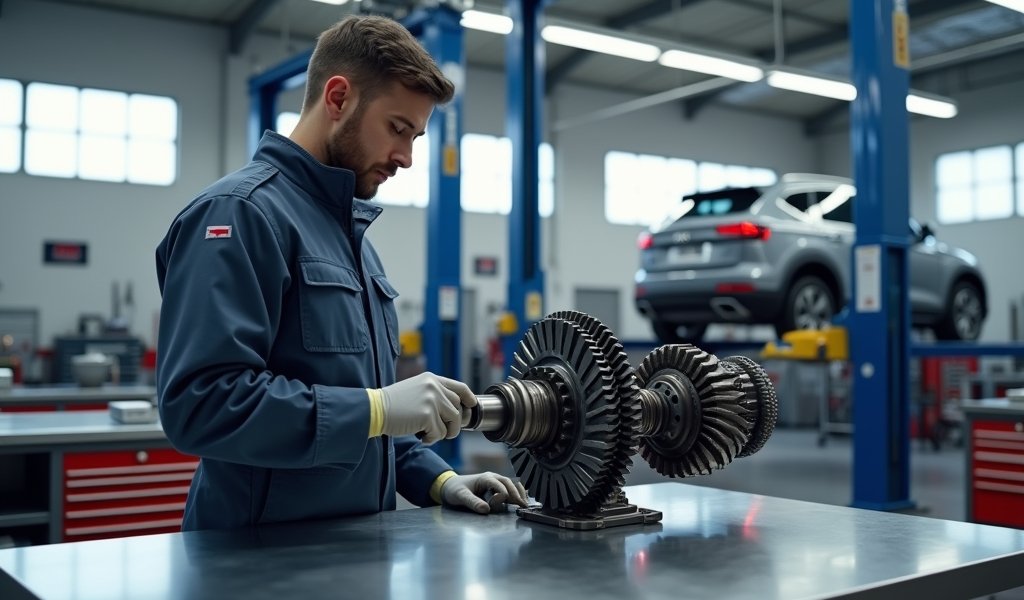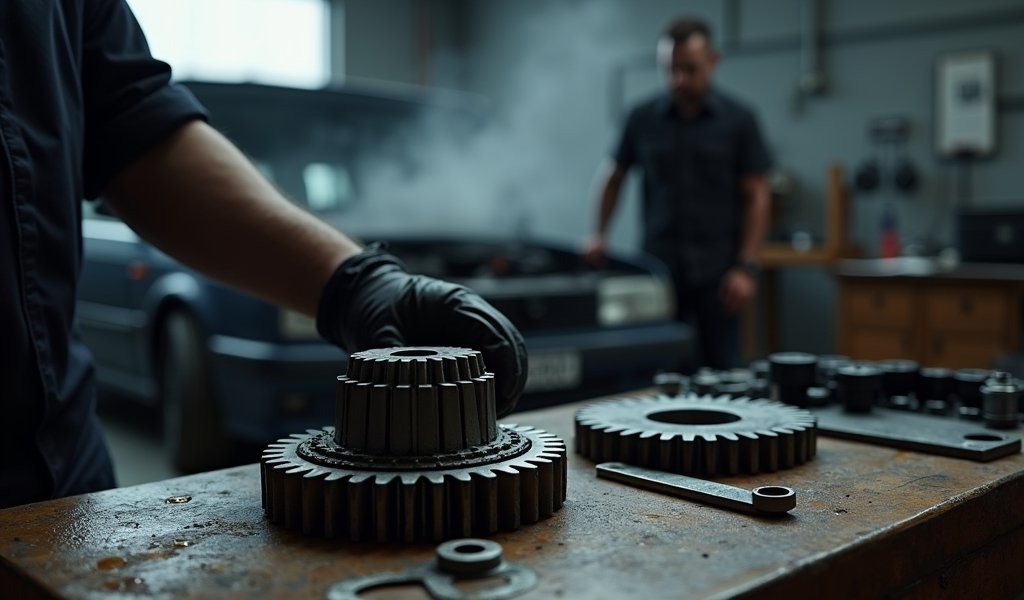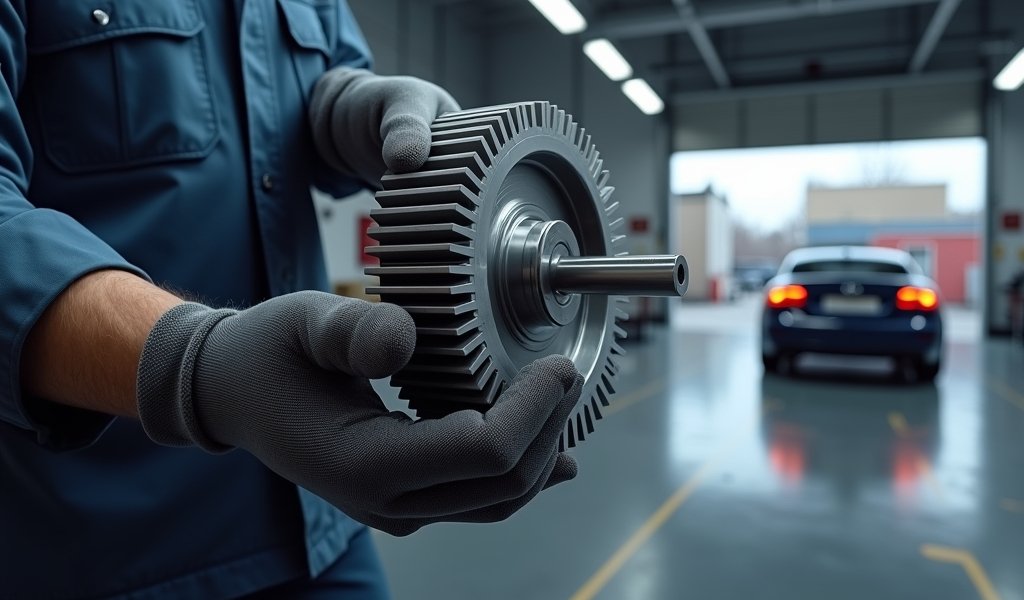Overview
This article provides five essential tips for effective planetary gear set inspection in transmissions: performing thorough visual checks, identifying wear patterns, measuring backlash/clearance, testing operation, and analyzing transmission fluid. Regular inspection of these critical components can prevent catastrophic transmission failures, potentially saving thousands in repair costs while extending transmission life.
Table of Contents
- Understanding Planetary Gear Sets
- Importance of Regular Inspection
- Tip 1: Visual Inspection
- Tip 2: Checking for Wear Patterns
- Tip 3: Measuring Backlash and Clearance
- Tip 4: Testing Planetary Operation
- Tip 5: Fluid Analysis
- Tools Needed for Inspection
- Preventive Maintenance
- Conclusion
- Frequently Asked Questions
Understanding Planetary Gear Sets
Performing a thorough planetary gear set inspection can save you thousands in costly transmission repairs down the road. As a mechanic with over 15 years of experience, I’ve seen my fair share of planetary gear failures that could have been prevented with proper maintenance. These ingenious mechanical systems are the heart of your transmission, working tirelessly every time you drive.
Think of planetary gear sets as miniature solar systems inside your transmission. The central “sun” gear connects to the input shaft, surrounded by “planet” gears that rotate within a “ring” gear. This clever arrangement allows for multiple gear ratios within a compact space, making modern automatic transmissions possible. When functioning properly, they transfer power smoothly through your vehicle’s drivetrain – but when problems develop, they can quickly cascade into major transmission issues.
Most drivers don’t give these components a second thought until something goes wrong. That’s understandable – they’re tucked away inside the transmission case, out of sight and mind. However, regular planetary gear set inspection is essential preventive maintenance that can extend the life of your transmission system significantly. Let’s dive into why these inspections matter and how to perform them properly.
Importance of Regular Inspection
Why bother inspecting something that seems to be working fine? Well, planetary gear sets rarely fail suddenly without warning signs. Instead, they gradually develop wear patterns and minor damage that, if caught early, can be addressed before catastrophic failure occurs. According to the National Highway Traffic Safety Administration, transmission failures are among the most expensive vehicle repairs, averaging $3,500 to $5,000 for a complete rebuild.
Regular planetary gear set inspection becomes particularly important once your vehicle passes the 75,000-mile mark. By this point, even well-maintained transmissions begin showing early signs of wear. Catching these issues during routine maintenance can mean the difference between a minor repair and a complete transmission replacement.
I’ve had customers come in needing complete rebuilds who could have saved thousands with earlier inspection. One particular case involved a 2015 Ford F-150 owner who ignored a slight shudder during gear changes. By the time he brought it in, metal fragments had contaminated the entire transmission system. A simple inspection just months earlier would have revealed early planetary wear that could have been addressed for under $600.

Tip 1: Visual Inspection
The first step in any planetary gear set inspection is a thorough visual examination. This requires removing the transmission pan and, in most cases, the valve body to gain access to the planetary assemblies. It’s not a job for the faint of heart, but for those comfortable with transmission work, it provides invaluable information about your transmission’s health.
Start by looking for obvious signs of damage or excessive wear. Healthy planetary gears should have evenly distributed wear patterns with no chipping, cracking, or missing teeth. The surfaces should appear smooth and consistent, with no evidence of scoring, pitting, or discoloration that might indicate overheating.
Pay special attention to the planet carrier assembly. This component holds the planet gears in proper alignment and bears significant stress during operation. Look for any cracks in the carrier, loose rivets, or excessive play in the planet gear bearings. Even minor damage here can quickly escalate into complete transmission failure.
The ring gear should be examined for uniform wear along the internal teeth. Any uneven wear patterns or heat discoloration are red flags suggesting abnormal operation. Similarly, inspect the sun gear for any signs of uneven tooth wear, especially at the tips of the teeth where damage often begins. When performing these checks, it’s helpful to use a professional diagnostic service for comprehensive transmission evaluation.
Tip 2: Checking for Wear Patterns
Wear patterns tell a story about how your planetary gear set has been operating. Learning to read these patterns is a crucial skill for effective inspection. Normal wear appears as evenly distributed polishing across gear teeth surfaces. Abnormal patterns suggest problems that need addressing.
One common issue I see is step wear, where one side of the gear teeth shows significantly more wear than the other. This typically indicates misalignment or improper clearances. If you spot step wear, you’ll need to investigate further to determine whether the issue stems from carrier misalignment, bearing wear, or another underlying problem.
Another telltale sign is tooth tip rounding. While slight rounding is normal after thousands of miles, excessive rounding indicates insufficient clearance or lubrication issues. I’ve seen cases where improper fluid levels led to accelerated wear that could have been prevented with routine maintenance.
Pitting – small depressions in the gear surface – suggests metal fatigue or possible contamination in the transmission fluid. These tiny pits can quickly grow into cracks and eventual tooth breakage if not addressed. Using a magnifying glass during inspection helps spot early pitting before it becomes severe.
The pattern of wear should be consistent across all planet gears. If one planet shows significantly more wear than others, it could indicate a bent shaft or carrier issue. This uneven loading places excessive stress on the entire assembly and requires immediate attention. According to research from the Society of Automotive Engineers, uneven planetary gear loading can reduce transmission life by up to 40%.
Tip 3: Measuring Backlash and Clearance
Precision is everything when it comes to planetary gear sets. The clearances between components are measured in thousandths of an inch, and even slight deviations can affect performance. Measuring backlash – the amount of play between meshing gear teeth – provides critical information about your gear set’s condition.
To measure backlash, you’ll need a dial indicator with a magnetic base. Mount the indicator so its plunger contacts the gear tooth surface perpendicular to the direction of movement. Hold one gear stationary while gently rocking the mating gear back and forth. The dial indicator will show the amount of movement, which should fall within manufacturer specifications (typically 0.004″ to 0.008″ for most passenger vehicles).
Excessive backlash indicates worn gear teeth or bearing issues. Insufficient backlash suggests improper assembly or potential binding under load. Both conditions accelerate wear and can lead to noise, vibration, and eventual failure.
Clearance between the planet gears and the carrier pins is equally important. Excessive clearance leads to planet gear misalignment and uneven loading. Use a feeler gauge to check this clearance, comparing your measurements against factory specifications. In most applications, this clearance should be between 0.001″ and 0.003″.
End play – the axial movement of components – also requires checking. Excessive end play allows components to shift during operation, leading to accelerated wear and potential engagement issues. A dial indicator can be used to measure end play by moving the component back and forth along its axis of rotation. The measurement should generally fall between 0.002″ and 0.010″, depending on the specific transmission model.
Tip 4: Testing Planetary Operation

A visual inspection only tells part of the story. To truly evaluate planetary gear set health, you need to observe it in operation. While complete testing requires specialized equipment, you can perform basic functional tests during your inspection.
Start by manually rotating each component to check for smooth operation. With the transmission disassembled, you should be able to rotate the sun gear, planet carrier, and ring gear independently (depending on which components are accessible in your particular transmission). The rotation should be smooth with no binding, catching, or rough spots.
Pay attention to unusual sounds during rotation. Clicking, grinding, or irregular sounds indicate potential problems with gear meshing or bearing wear. I’ve diagnosed numerous issues simply by listening carefully during manual rotation tests.
If possible, check clutch pack operation associated with the planetary set. Apply air pressure to the appropriate clutch apply passage and observe the clutch engagement. The clutch should engage firmly and evenly. Incomplete or uneven engagement suggests clutch pack issues that can affect planetary gear operation.
For a more comprehensive evaluation, consider using a transmission dynamometer if available. This equipment allows testing under load, providing the most accurate picture of planetary gear set health. While not accessible to most home mechanics, many professional inspection services offer dynamometer testing as part of their evaluation process.
Tip 5: Fluid Analysis
Transmission fluid doesn’t just lubricate – it tells a story. A proper planetary gear set inspection includes careful analysis of the transmission fluid, which can reveal problems before they become visible in the components themselves.
First, examine the fluid’s color and smell. Healthy transmission fluid is typically red or light brown with a distinctive petroleum odor. Dark brown or black fluid with a burnt smell suggests overheating – a common cause of planetary gear damage. A sweet or burnt smell may indicate clutch material contamination from slipping clutches.
Next, check for metal particles in the fluid. A small amount of fine metallic dust is normal in high-mileage transmissions, but larger particles or excessive amounts of metal suggest accelerated wear. I keep a magnet handy during inspections to test particles – ferrous metal (attracted to the magnet) typically comes from gears and bearings, while non-ferrous particles often come from bushings or thrust washers.
For the most accurate analysis, consider sending a fluid sample to a specialized laboratory. Professional fluid analysis can identify specific metals present in the fluid and their concentrations, pinpointing which components are wearing abnormally. This service typically costs $20-$40 but can provide early warning of developing issues.
If you find significant metal contamination during your inspection, be sure to thoroughly flush the transmission cooler and lines before reassembly. Metal particles circulating through the system will quickly damage newly installed components. Many professional rebuilders use a transmission flush machine that forces cleaning solution through the entire system, removing contaminants from hard-to-reach areas.
Tools Needed for Inspection
Performing a proper planetary gear set inspection requires specific tools beyond the basic wrench set. Having the right equipment makes the job easier and ensures accurate assessment. Here’s what you’ll need:
- Transmission jack or support – For safely removing and supporting the transmission
- Transmission pan – To catch fluid during disassembly
- Socket set with extensions – For removing bolts in tight spaces
- Torque wrench – For proper reassembly
- Dial indicator with magnetic base – For measuring backlash and endplay
- Feeler gauge set – For checking clearances
- Snap ring pliers – For removing retaining rings
- Transmission fluid pump – For refilling after inspection
- Magnet – For checking metal particles in fluid
- Digital camera or smartphone – For documenting component positions during disassembly
- Manufacturer service manual – For specifications and procedures
Investment in quality tools pays dividends in accuracy and time saved. I particularly recommend investing in a good dial indicator – this single tool provides the most critical measurements for evaluating planetary gear health. A quality indicator will cost $50-$100 but will last for decades of use.
If you’re serious about transmission work, consider adding a borescope to your toolkit. These camera-equipped inspection devices allow visual examination of components without complete disassembly. Basic models connect to smartphones and cost under $50, making them accessible to home mechanics.
Preventive Maintenance
The best planetary gear set inspection is the one you never need to perform because you’ve prevented damage through proper maintenance. Preventive care dramatically extends transmission life and reduces the need for costly repairs.
Regular fluid changes are your first line of defense. Transmission fluid breaks down over time, losing its lubricating properties and ability to prevent corrosion. Most manufacturers recommend changing fluid every 30,000-60,000 miles, though severe service conditions may require more frequent changes. Always use the specific fluid type recommended for your transmission – using incorrect fluid can cause more harm than good.
Transmission temperature management is equally important. Excessive heat accelerates fluid breakdown and component wear. If you regularly tow or drive in severe conditions, consider adding an auxiliary transmission cooler. These relatively inexpensive devices can lower transmission temperatures by 20-50°F, dramatically extending component life.
Pay attention to early warning signs. Delayed engagement, unusual noises, or vibrations during shifting often indicate developing problems. Addressing these symptoms early can prevent damage to the planetary gear sets. Many drivers ignore minor symptoms until they become major failures – a costly mistake.
Finally, consider transmission servicing rather than simple fluid changes. A proper service includes filter replacement, pan cleaning, and inspection of the magnet for metal particles. This more thorough maintenance provides better protection and early warning of developing issues. Most transmission specialists recommend a complete service every 60,000 miles for normal driving conditions.
Conclusion
A thorough planetary gear set inspection is one of the most valuable services you can perform for your vehicle’s transmission. By following these five tips – performing visual inspection, checking wear patterns, measuring clearances, testing operation, and analyzing fluid – you’ll catch potential problems before they become expensive failures.
Remember, transmissions rarely fail without warning. The subtle signs are there if you know what to look for, and regular inspection is the key to identifying them early. While planetary gear set inspection requires some technical knowledge and special tools, the investment pays off through extended transmission life and avoided repair costs.
Whether you’re a DIY enthusiast with the skills to perform your own inspection or you rely on a trusted professional, make planetary gear set health a priority in your vehicle maintenance schedule. Your transmission – and your wallet – will thank you for years to come.
Frequently Asked Questions
How often should I inspect my planetary gear set?
Most mechanics recommend inspection every 60,000 miles or anytime transmission symptoms occur. Earlier inspection is advised for vehicles under severe duty conditions like towing or frequent stop-and-go driving.
Can I inspect the planetary gear set without removing the transmission?
Limited inspection is possible by removing the pan and valve body on some models. Complete inspection requires transmission removal in most vehicles.
What are the warning signs of planetary gear failure?
Common symptoms include unusual noises during shifting, delayed engagement, slipping, and metal particles in the transmission fluid. You might also experience vibration or shuddering during specific gear ranges.
How much does a professional planetary gear inspection cost?
Professional inspection costs typically range from $150-$350 depending on vehicle make and transmission accessibility. This usually includes removal of the pan and visual inspection of accessible components.
Can planetary gears be repaired individually or is a complete rebuild necessary?
Individual planetary components can sometimes be replaced if caught early. Advanced damage typically requires complete rebuilding as metal particles contaminate the entire system.

